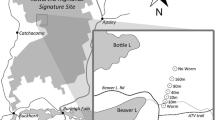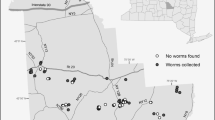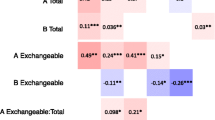Abstract
In many mid-Atlantic forests where both native and non-native earthworms exist, it is the non-native species that are the dominant component of the soil macrofauna. Few earthworm ecology studies, however, focus attention on these forest systems in order to determine the relative ecological roles and potential interactions of the native and non-native earthworms. In a series of field samplings and experimental manipulations we collected data on the effects of earthworms on below-and aboveground ecosystem processes. Earthworm abundance and the ecological processes measured were dynamic in space and time across the range of study sites. Leaf litter decay rates doubled at sites that had abundant non-native earthworms. Earthworms also altered the abundance of soil fungi, the activity of extracellular enzymes, soil respiration, and the growth of tree seedlings but the effects varied among sites depending on differences in land-use history and forest age. Red oak seedling growth was less at sites that had abundant earthworms but tulip poplar and red maple seedlings grew equally well with and without abundant earthworms. These preliminary results suggest that non-native earthworms have significant ecosystem effects, even in forests where native earthworms still occur. Land use history, however, plays an important role in determining what those effects will be, and these effects are likely to be dynamic, depending on the abundance of non-native earthworms.






Similar content being viewed by others
References
Abrams MD, Downs JA (1990) Successional replacement of old-growth white oak by mixed mesophytic hardwoods in southwestern Pennsylvania. Can J Forest Res 20:1864–1870
Alban DH, Berry E (1994) Effects of earthworm invasion on morphology, carbon, and nitrogen of a forest soils. Appl Soil Ecol 1:246–249
Allison SD, Jastrow JD (2006) Activities of extracellular enzymes in physically isolated fractions of restored grassland soils. Soil Biol Biochem 38:3245–3256
Blair JM (1988) Nitrogen, sulfur and phosphorous dynamics in decomposing deciduous leaf litter in the southern Appalachians. Soil Biol Biochem 20:693–701
Blair JM, Parmelee RW, Lavelle P (1995) Influences of earthworms on biogeochemistry. In: Hendrix PF (ed) Earthworm ecology and biogeography in North America. Lewis Publ, Boca Raton, pp 128–154
Blakemore RJ (2006) American earthworms (Oligochaeta) from North of Rio Grande—a species checklist. In: Kaneko N, Ito MT (eds) A series of searchable texts on earthworm biodiversity, ecology and systematics from various regions of the world, 2nd edn. COE Soil Ecology Research Group, Yokohama National University, Japan, pp 1–16 CD-ROM
Bohlen PJ, Parmelee RW, Blair JM, Edwards CA, Stinner BR (1995) Efficacy of methods for manipulating earthworm populations in large-scale field experiments in agroecosystems. Soil Biol Biochem 27:993–999
Bohlen PJ, Edwards CA, Zhang Q, Parmelee RW, Allen M (2002) Indirect effects of earthworms on microbial assimilation of labile carbon. Appl Soil Ecol 20:255–261
Bohlen PJ, Groffman PM, Fahey TJ, Fisk MC, Suárez E, Pelletier DM, Fahey RT (2004a) Ecosystem consequences of earthworm invasion of north temperate forests. Ecosystems 7:1–12
Bohlen PJ, Groffman PM, Fahey TJ, Fisk MC (2004b) Influence of earthworm invasion on redistribution and retention of soil carbon and nitrogen in northern temperate forests. Ecosystems 7:13–29
Bohlen PJ, Scheu S, Hale CM, McLean MA, Migge S, Groffman PM, Parkinson D (2004c) Non-native invasive earthworms as agents of change in northern temperate forests. Front Ecol Environ 8:427–435
Bossuyt H, Six H, Hendrix PF (2005) Protection of soil carbon by microaggregates within earthworm casts. Soil Biol Biochem 37:251–258
Bouche MB (1977) Strategies lombriciennes. In: Lohm U, Persson T (eds) Soil organisms as components of ecosystems. Ecol Bull 25. Stockholm, pp 122–132
Brush GS, Lenk C, Smith J (1980) The natural forests of Maryland: an explanation of the vegetation map of Maryland. Ecol Monogr 50:77–92
Burtelow AE, Bohlen PJ, Groffman PM (1998) Influence of exotic earthworm invasion on soil organic matter, microbial biomass and denitrification potential in forest soils of the northeastern United States. Appl Soil Ecol 9:197–202
Caravaca F, Pera A, Masciandaro G, Geccanti B, Roldan A (2005) A microcosm approach to assessing the effects of earthworm inoculation and oat cover cropping on CO2 fluxes and biological properties in an amended semiarid soil. Chemosphere 59:1625–1631
Coleman DC, Crossley DA Jr (1996) Fundamentals of soil ecology. Academic Press, Amsterdam
Costello DM, Lamberti GA (2009) Biological and physical effects of non-native earthworms on nitrogen cycling in riparian soils. Soil Biol Biochem 41:2230–2235
Crow SE, Filley TR, McCormick MK, Szlavecz K, Stott DE, Gamblin D, Conyers G (2009) Invasive earthworm feeding and forest succession interact to influence particulate organic matter chemistry in the soil. Biogeochemistry 92:61–82
Csuzdi CS, Zicsi A (2003) Earthworms of Hungary. Hungarian Natural, History Mus Publ., Budapest
Dornbush ME, Isenhart TM, Raich JW (2002) Quantifying fine-root decomposition: an alternative to buried litterbags. Ecology 83:2985–2990
Fierer N, Jackson JA, Vilgalys R, Jackson RB (2005) Assessment of soil microbial community structure by use of taxon-specific quantitative PCR assays. Appl and Environ Microb 71:4117–4120
Filley TR, McCormick MK, Crow SE, Szlavecz K, Whigham DF, Taylor DL, Johnston CT, van den Heuvel R (2008) Comparison of the chemical alteration trajectory of liriodendron tulipifera litter among forests with different invasive earthworm activity. J Geophys Res. doi:10.1029/2007JG000542
Fisk MG, Fahey TJ, Groffman PM, Bohlen PJ (2004) Earthworm invasion, fine-root distributions, and soil respiration in North temperate forests. Ecosystems 7:55–62
Grandy A, Sinsabaugh RL, Neff JC, Stursova M, Zak DR (2008) Nitrogen deposition effects on soil organic matter chemistry are linked to variation in enzymes, ecosystems and size fractions. Biogeochemistry 91:37–49
Groffman PM, Bohlen PJ, Fisk MC, Fahey TJ (2004) Exotic earthworm invasion and microbial biomass in temperate forest soils. Ecosystems 7:45–54
Guggenberger G, Tomas RJ, Zech W (1996) Soil organic matter within earthworm casts of an anecic-endogeic tropical pasture community, Colombia. Appl Soil Ecol 3:263–274
Haimi J (1995) Effect of introduced earthworm Aporrectodea velox on nutrient dynamics of forest soil. Acta Zool Fennica 196:67–70
Hale CM, Frelich LE, Reich PB et al (2005) Effects of European earthworm invasion on soil characteristics in northern hardwood forests of Minnesota, USA. Ecosystems 8:911–927
Hendrix PF (1995) Earthworm ecology and biogeography in North America. Lewis Publishers, Boca Raton (FL)
Hendrix PF, Bohlen PJ (2002) Exotic earthworm invasions in North America: ecological and policy implications. Bioscience 52:801–811
Hendrix PF, Baker GH, Callahan MA Jr et al (2006) Invasion of exotic earthworms into ecosystems inhabited by native earthworms. Biol Invasions 8:1287–1300
Higman D (1968) An ecologically annotated checklist of the vascular flora at the Chesapeake Bay center for field biology. with keys. Smithson Inst Press, Wash, DC
Hobbie SE, Reich PB, Oleksyn J et al (2006) Tree species effects on decomposition and forest floor dynamics in a common garden. Ecology 87:2288–2297
Hogberg P, Nordgren A, Buchmann N, Taylor AFS, Ekblad A, Hogberg MN, Nyberg G, Ottosson-Lofvenius M, Read DJ (2001) Large-scale forest girdling shows that current photosynthesis drives soil respiration. Nature 411:789–792
Holdsworth AR, Frelich LE, Reich PB (2008) Litter decomposition in earthworm invaded northern hardwood forests: role of invasion degree and litter chemistry. Ecoscience 15:536–544
Hutchinson GL, Mosier AR (1981) Improved cover soil method for field measurement of nitrous oxide fluxes. Soil Sci Soc Am J 45:311–316
Johansson MB, Ber B, Meentemeyer V (1995) Litter mass loss rates in late stages of decomposition in a climatic transect of pine forests. Long-term decomposition in Scots pine forest. IX. Can J Bot 73:1509–1521
Jones CG, Lawton JH, Shachak M (1994) Organisms as ecosystem engineers. Oikos 69:373–386
Keeler BL, Hobbie SE, Kellogg LE (2009) Effects of long-term nitrogen addition on microbial enzyme activity in eight forested and grassland sites: implications for litter and soil organic matter decomposition. Ecosystems 12:1–15
Lawrence B, Fisk MC, Fahey TJ, Suárez ER (2003) Influence of nonnative earthworms on mycorrhizal colonization of sugar maple (Acer saccharum). New Phytol 157:145–153
Lovelock CE, Miller R (2002) Heterogeneity in inoculum potential and effectiveness of arbuscular mycorrhizal fungi. Ecology 83:823–832
Martin A, Marinissen JCY (1993) Biological and physico-chemical processes in excrements of soil animals. Geoderma 56:331–347
McMahon SM, Parker GG, Miller DR (2010) Evidence for a recent increase in forest growth. P Natl Acad Sci USA 107:3611–3615
Melillo JM, Aber JD, Muratore JF (1982) Nitrogen and lignin control of hardwood leaf litter decomposition dynamics. Ecology 63:621–626
Pierce JW (1974) Soil mineral analyses. In: Correll DL (ed) Environmental monitoring and baseline data. Compiled under the Smithsonian institution environmental sciences program. Temperate studies, vol III. Chesapeake Bay Center for Environmental Studies, Edgewater, MD, pp 1113–1129
Poirier N, Sohi SP, Gaunt JL, Mahieu N, Randall EW, Powlson DS, Evershed RP (2005) The chemical composition of measurable soil organic matter pools. Org Geochem 36:1174–1189
Raich JW, Russell AE, Valverde OB (2009) Fine roots decay vary widely among lowland tropical tree species. Oecologia 161:325–330
Raw F (1959) Estimating earthworm populations by using formalin Nature 184:1661–1662
Robertson GP, Wedin D, Groffman PM, Blair JM, Holland EA, Nadelhoffer KJ, Harris D (1999) Soil carbon and nitrogen availability: nitrogen mineralization, nitrification, and soil respiration potentials. In: Robertson GP, Coleman DC, Bledsoe CS, Sollins P (eds) Standard soil methods for long-term ecological research. Oxford Univ Press, New York, pp 258–271
Scheu S, Parkinson D (1994a) Effects of invasion of an aspen forest (Canada) by Dendrobaena octaedra (Lumbricidae) on plant growth. Ecology 75:2348–2361
Scheu S, Parkinson D (1994b) Effects of earthworms on nutrient dynamics, carbon turnover and microorganisms in soils from cool temperate forests of the Canadian Rocky Mountains—laboratory studies. Appl Soil Ecol 1:113–125
Schmidt O (2001) Appraisal of the electrical octet method for estimating earthworm populations in arable land. Ann Appl Biol 138:231–241
Six J, Conant RT, Paul EA, Paustian K (2002) Stabilization mechanisms of soil organic matter: implications for C-saturation of soils. Plant Soil 241:155–176
Sollins P, Swanston C, Kleber M, Filley TR, Kramer M, Crow SE, Caldwell B, Lajtha K, Bowden R (2006) Organic C and N stabilization in a forest soil: evidence from sequential density fractionation. Soil Biol Biochem 38:3313–3324
Staddon PL, Ostle N, Fitter AH (2003) Earthworm extraction by electroshocking does not affect canopy CO2 exchange, root respiration, mycorrhizal fungal abundance or mycorrhizal fungal vitality. Soil Biol Biochem 35:421–426
Steinberg DA, Pouyat RV, Parmelee RW, Groffman PM (1997) Earthworm abundance and nitrogen mineralization rates along an urban-rural land use gradient. Soil Biol Biochem 29:427–430
Suarez ER, Fahey TJ, Yavitt JB, Groffman PM, Bohlen PJ (2006) Patterns of leaf litter disappearance in a northern hardwood forest invaded by exotic earthworms Ecol Appl 16:154–165
Szlavecz K, Csuzdi CS (2007) Land use change affects earthworm communities in Eastern Maryland, USA. Eur J Soil Biol 43:79–85
Szlavecz K, Placella SA, Pouyat RV, Groffman PM, Csuzdi CS, Yesilonis I (2006) Invasive earthworm species and nitrogen cycling in remnant forest patches. Appl Soil Ecol 32:54–63
Tang J, Mission L, Gershenson A, Cheng W, Goldstern AH (2005) Continuous measurements of soil respiration with and without roots in a ponderosa pine plantation in the Sierra Nevada Mountains. Agr Forest Meteorol 132:212–227
Thielemann U (1986) Electrischer Regenwurmfang mit der Oktett-Methode. Pedobiologia 29:296–302
Wan S, Luo Y (2003) Substrate regulation of soil respiration in a tallgrass prairie: results of a clipping and shading experiment. Glob Biogeochem Cycles 17:1054. doi:10.1029/2002GB001971
Weyers SL, Schomberg HH, Hendrix PF, Sokas KA, Endale DM (2008) Construction of an electrical device for sampling earthworm populations in the field. Appl Eng Agric 24:391–397
Wironen W, Moore TR (2006) Exotic earthworm invasion increases soil carbon and nitrogen in an old growth forest in Southern Quebec. Can J of For Res 36:845–854
Wright JP, Jones CG (2006) The concept of organisms as ecosystem engineers ten years on: progress, limitations, and challenges. Bioscience 56:203–209
Acknowledgments
This study was supported by grants from the United States Department of Agriculture (USDA-CSREES NRI 2007-35320-18375, the National Science Foundation (EAR-0748442, EEC-0540832 ERC-MIRTHE), and Microsoft Research. We are most grateful to Scott Pitz and Jay O’Neill, who were instrumental in establishing the field manipulations and subsequent monitoring. Several undergraduates and SERC volunteers provided help in the field: Sarah Frank, Peter Houlihan, Helen Huang, Miriam Johnston, and Kerry Good. Alex Szalay designed and built the shocking equipment. We also thank two anonymous reviewers and Ronaldo Sousa for helpful comments on an earlier version of this manuscript.
Author information
Authors and Affiliations
Corresponding author
Rights and permissions
About this article
Cite this article
Szlavecz, K., McCormick, M., Xia, L. et al. Ecosystem effects of non-native earthworms in Mid-Atlantic deciduous forests. Biol Invasions 13, 1165–1182 (2011). https://doi.org/10.1007/s10530-011-9959-0
Received:
Accepted:
Published:
Issue Date:
DOI: https://doi.org/10.1007/s10530-011-9959-0




